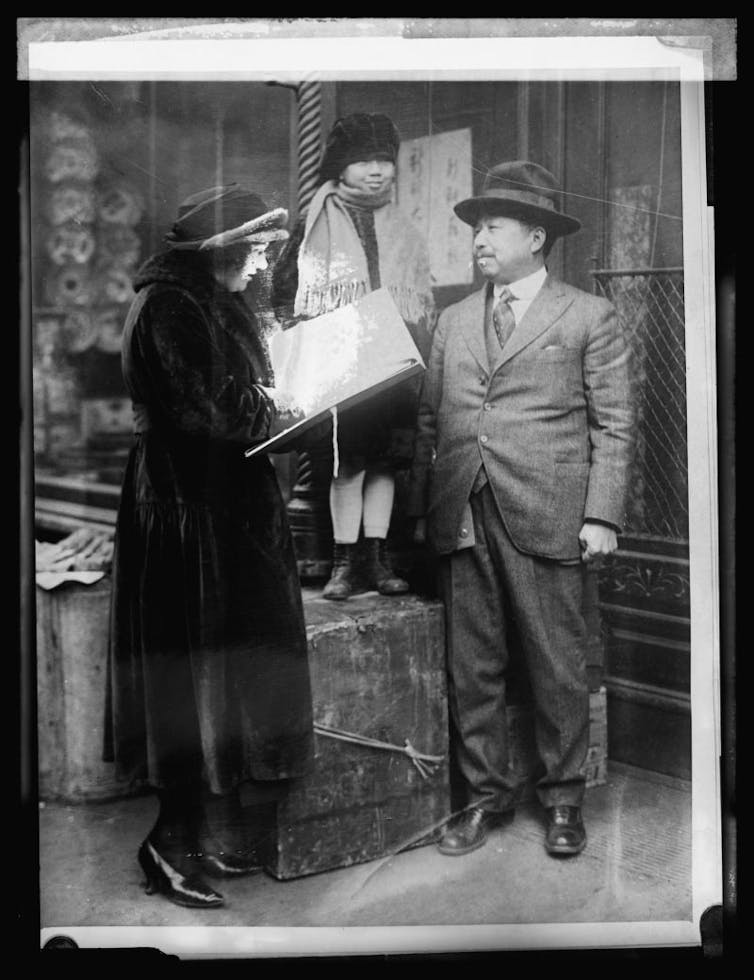
Experts in autocracies have pointed out that it is, unfortunately, easy to slip into normalizing the tyrant, hence it is important to hang on to outrage. These incidents which seem to call for the efforts of the Greek Furies (Erinyes) to come and deal with them will, I hope, help with that. As a reminder, though no one really knows how many there were supposed to be, the three names we have are Alecto, Megaera, and Tisiphone. These roughly translate as “unceasing,” “grudging,” and “vengeful destruction.”
Now that the impeachment “trial” is over for now, and the election still a ways off, I thought maybe some of us might be looking for something else to worry about. (Just kidding, of course – I know there is plenty to worry about. But this is germane to some things we are already worrying about, and probably should not be ignored.)
==================================================================
100 years ago, Congress threw out results of the census

Library of Congress
Walter Reynolds Farley, University of Michigan
The 2020 Census hasn’t even started – but it has already kicked off spirited fights.
A Supreme Court case, decided last year, blocked a Trump administration proposal to ask every respondent if they were a citizen.
Meanwhile, there are three pending federal court suits in which plaintiffs for civil rights groups and one city claim that the administration has not done sufficient planning or provided enough funding for Census 2020.
Census 2020 is far from the first census to set off bitter political fights. One hundred years ago, results from Census 1920 initiated a decadelong struggle about how to allocate a state’s seats in Congress. The political arguments were so bitter that Congress eventually decided they would not use Census 1920 results.
Could this happen again?
Power in the census
The framers of the Constitution mandated a count of all people every ten years, in order to allocate seats in Congress and the Electoral College on the basis of each state’s population.
The results of the census shift political power and money. At present, US$1.5 trillion in federal spending is distributed to states and local governments every year on the basis of data gathered by the Census Bureau.
I am a demographer who has been teaching about the nation’s population trends since the early 1960s. I have analyzed census data for decades. In Census 2000, I was an enumerator and Census 2010, an address lister.
The 2020 Census asks just seven questions. Back in 1910, the census posed 32 questions, with an additional array of questions for farmers. One of those queries asked farmers the value of the products they sold during the previous year.
Since 1790, the official census start date had been either the first Monday of August or June 1. But, for the 1920 census, the Department of Agriculture presumed they would obtain more accurate information about the value of crops if the census were taken on Jan. 1. They feared farmers would forget financial details over the winter.
Congress approved the change without realizing the implications.

Library of Congress
Immigration influx
Census 1920 results were released in December of that year, and they surprised the members of Congress.
At that time, there was vibrant opposition to foreigners coming into the U.S. The nation had already banned immigration from Asia, but many of those arrived after 1880 were Catholics and Jews who came from southern and eastern Europe. Many Americans feared they would never assimilate.
The 1920 census results showed that the Northeastern and industrial Midwestern states had grown rapidly, thanks to immigration from Europe. After an interruption for World War I, immigration spiked to 800,000 in 1920.
In response to census results and the unexpected “flood” of immigrants, Congress, in 1921, enacted an Emergency Immigration Quota Act, restricting immigration.
The lost census
That was just the first step in a decadelong controversy involving key issues that shaped the nation. Would there be continued immigration from eastern and southern Europe? Would political power shift to the states with the biggest cities?
The 1920 results would have shifted political power away from the South and away from the agricultural states of the Midwest, to the northeastern states and those states Americans now call the Rust Belt.
Representatives of farm states contended that the new Jan. 1 census date meant that many men who spent most of the year working on farms were counted in cities where they spent just a few winter months.
Southerners in Congress argued that congressional seats should be allocated on the number of citizens only, since this would protect their representation.
Congressmen from growing states emphasized that the Constitution said nothing about citizens. They argued that a constitutional amendment was required to limit congressional apportionment to citizens only.
Northeastern members also pointed to an obscure clause from the 14th Amendment that permitted Congress to diminish a state’s representation if they determined that a state abridged the right of male citizens to vote. Southern states attempted to accomplish that with poll taxes, literacy tests, grandfather clauses and refusal to register African Americans.
There was also controversy about which mathematical method to use to allocate seats to states. Different methods assigned different numbers of seats to states.
From 1800 to 1910, Congress had increased its membership after censuses, to prevent states from losing a seat. Vibrant controversy raged about the size of Congress, since different numbers favored different states.
Late in the 1920s, it became clear that Congress was so riven they would never use Census 1920 data to reapportion Congress. In 1929, they enacted legislation specifying which method would be used to allocate seats on the basis of the 1930 count.
Census 1920 is unique, since it was the only one not used for reapportionment.

U.S. Census Bureau
Echoes of the past
Is there any chance the census count of 2020 will be dismissed?
Just as in the 1920, there are conflicting views today about immigration and how much representation states should have in Congress and the Electoral College.
In the pending federal suits, plaintiffs contend that the administration’s lack of sufficient planning and funding will substantially undercount Americans, especially minority groups.
Should federal judges find in the plaintiff’s favor, members of Congress may be skeptical about data from Census 2020.
What’s more, at present, there are many individuals and several organizations arguing that congressional and Electoral College seats should be allocated according to the count of citizens or the count of voting age citizens, as opposed to all residents.
The state of Alabama has already filed suit contending that Alabama will likely lose a seat to Texas because aliens are included in the count used to apportion seats. If Congress were to apportion seats on the basis of citizens only, the Supreme Court may have to rule about what the framers of the Constitution meant when they defined the apportionment population.
Finally, the nation’s population is currently three times as large as in 1911, when Congress decided that 435 was the appropriate size of membership. On the basis of 2019 data, it seems likely that 10 states will lose a representative.
Some political analysts and advocates favor an expansion of Congress, since that would mean that members would represent fewer constituents. If Congress, next year, decided to increase its size to 460, no state would lose any of its current seats.
A new Congress will be elected this November and they will meet for the first time on Jan. 3, 2021. One of their first obligations will be reapportionment. Will this go smoothly – or will the controversies of the 1920s once again influence what use Congress makes of census counts?
[Like what you’ve read? Want more? Sign up for The Conversation’s daily newsletter.]![]()
Walter Reynolds Farley, Professor Emeritus of Sociology, University of Michigan
This article is republished from The Conversation under a Creative Commons license. Read the original article.
==================================================================
I really have nothing else to say. There are, of course, people and groups already working on the conduct of the census. At least this time the quantity of immigration should not come as a surprise to anyone – except maybe to those who have exaggerated it for reasons of spreading fear. It does make the 2020 elections – at all levels – at least down to and including state legislatures – loom even larger than it already does.
Alecto, Megaera, and Tisiphone, please help everyone who is on the ground (including the phones) working to get out the vote. And that goes double in states which have histories of making it more difficult for some people to vote than for others. And show us who are not able to be there and do that ways in which we can help those unsung heroes (and heroines) in their work.
The Furies and I will be back.
12 Responses to “Everyday Erinyes #203”
Sorry, the comment form is closed at this time.

I began a membership with Ancestry.com last fall. Part of the data available there are old census data. It’s amusing and edifying. The last census released was 1940, they hold them for 72 years, so the 1950 census won’t be available until 2022. What I found amusing is that they were taken by hand. My maternal family name is Nolby (which is the name of the town in Sweden they emigrated from – original name was Andersson and the patriarch declared there were too many of them here and changed the surname on arrival) but as I went through the various census reports I found just countless transcription and misspelling errors. Incomplete data, incorrect data, wrong number of people in the household. Nolby became Nolly Nooly Nobly, etc. I did see as family members were born additions to the households but the inaccuracies just make me wonder if we’ve ever gotten it right.
I have participated in quite a number of censuses myself over the course of time, they’ve all varied, some short form, some long form, some combinations. The argument I hear most often these days is that the large states are shortchanged in the Senate. Why should South Dakota with it’s 888,000 people get two when California with it’s 39.5 MILLION people get two. I mean, I know the Founder’s reasoning, but I don’t think any of them anticipated the size to which this nation, or the world, would grow. Maybe it is time to rethink the numbers of both Houses as well as the number of Senators along with the electoral college system in light of what is now opposed to what was then. I know small states worry they’ll be ignored but a popular vote is a more reasonable system than what we have now which is little more than a circus.
I’ve never belonged to ancestry, but I am a superfan of “Finding Your Roots,” so I’m aware how censuses are used in genealogy. I also worked as an enumerator for the 1980 census, which was still done by hand on the ground (the data was fed into computers, keyed in). One of the enumerators was caught making data up, and only caught by accident. So I agree with you that the census probably never was and never will be accurate to the last digit. But that doesn’t mean we shouldn’t strive for it, nor does it mean that the data is unusable. I do think it might be a good idea to start enforcing the 14th Amendment, though.
An interesting readable post.
I’ve nothing to add to this, as the comments above, pretty much say it all.
Thanks, Joanne and Furies, for getting this info out here, and..YES…KUDOS to those who are working hard at this.
Thank’s JD. It is very interesting.
The Constitution is clear about one thing. We are to count the people, not the citizens, not the adults, not the voters, etc. Bought Bitch Midnight Moscow Mitch will want it based on the count of registered Republicans.
The Rethuglicans will try to use the census for their own, very greedy, purposes. Hopefully, some courts will block their ongoing attempts, to do so.
Excellent, very clarifying article. With Republicans in power now, chances are they will abuse this year census for their own gain. I agree with Gene that its use for redistribution purposes can be overcome by going to the popular vote.
For the Presidency, yes. It’s not so easy when it comes to the House of Representatives. I in Colorado would have a rough time picking seven to vote for, and I’m fairly aware. Those who are less so would be tempted to give up. And California has 53 representatives. Some are good, some are terrible – but I don’t think anyone would be truly informed enough to vote in 53 races.
Thanks Joanne! I am wondering about whether the keeping males from voting element might appear in 2020 court action related to felon disenfranchisement and other documented voter suppression/purging efforts…History indicates the senate rules was designed to ensure sufficient slave state votes and thus still functions for white voice dominance…and I’d welcome CA getting another to help balance and not have my vote increasingly diluted for a lifetime.
“I’ve never belonged to ancestry, but I am a superfan of “Finding Your Roots,” so I’m aware how censuses are used in genealogy. ” Couldn’t get the reply feature to give me a comment box for some reason.
One of the things I found amusing about Ancestry (and to check did a 23andMe DNA test too) was that all of 8 of my great grandparents were immigrants from Sweden. I was told all my life that we were 100% Swedish. We acted like it, at least on my mom’s side, her family were loggers when they arrived and built the little Lutheran church I grew up in.
But the ancestry results have me at 53% Swedish, 29% Norwegian and 18% England/Wales. 23andMe has me at 71.6% Scandinavian, 12.3 French and German, 6.3 British and Irish, and 9.8 Broadly Northwestern European. The maps are pretty much identical.
I asked a friend in Sweden about this and she told me that in the 17th and 18th centuries Sweden was something of a world power but didn’t have enough labor for its various businesses and so imported labor from generally, England, France and Germany, hence the mixture. I guess the Norwegian parts come from the fact that on both sides of the family we were not far from the Norwegian border. So I’m not quite as pure as I thought. :^). I’ve traced my mother’s family back five generations but haven’t gone so far with my dad’s side. I’ve found it isn’t actually useful to know who my sixth set of great grandparents were or what they did. The only records back that far are baptismal and in Swedish – another reason to learn the language I suppose. I think I’ll keep the membership another six months and hope I find more motivation. It’s a tedious process. I am looking forward to 2022’s release as that one will show me things about my family here that I don’t as I am really the only one left, being the oldest grandchild on both sides of the family. I’ve lost touch with my dad’s side, there were 12 kids and they scattered across the country, my mother’s side stayed in Minnesota, both maternal and paternal lines. I’ve learned a lot about people I never met there. It is interesting, if not useful, and since retirement I’ve been working puzzles of all kinds to stay mentally “fit”. Though the largest puzzle I’m working right now is how the hell we get a candidate capable of beating trump out of the current lot all of whom I have serious doubts about. Sigh.
Interesting that you can learn so much about history basically just from your own DNA. Bit it makes sense.
Interesting overview of the Censes system and how it works.
Thanks Joanne
An honest Census will be critical for continuing our democratic republic.
Not sure it’s doable given who is occupying our Oval Office.